Chinese (Mandarin)/Numbers
< Chinese (Mandarin)Number System (數字系統)
基本用字 Basic Characters
![]() Listen to audio
Listen to audio
- 0: 零: líng
- 1: 一 (壹) yī
- 2: 二 (Traditional:貳) èr
- 3: 三 (Traditional:參) sān
- 4: 四 (肆) sì
- 5: 五 (伍) wǔ
- 6: 六 (Traditional:陸) liù
- 7: 七 (柒) qī
- 8: 八 (捌) bā
- 9: 九 (玖) jiǔ
- 10: 十 (拾) shí
- 100: 百 (佰) bǎi
- 1,000: 千 (仟) qiān
- 10,000: 万 (萬) wàn (1'0000)
- 100,000: 十万 (萬) shíwàn (10'0000)
- 1,000,000: 一百万 (萬) yībǎi wàn (100'0000)
- 100,000,000: Traditional 一亿 (億) yīyì (1'0000'0000)
- 1,000,000,000,000: 一兆 yīzhào (1'0000'0000'0000)
Parenthesized entries are the complex forms, which are used mainly in notarized, official documents, and when writing checks. An exception is zero; the complex form is more widely used. The complex forms are known in English as banker's anti-fraud numerals, in Chinese as 大寫 dàxiě (which is the same term for "capital letter"). They are necessary because, since normal Chinese characters are so simple, a forger could easily change 三十 to 五千 with just three strokes. Some have other uses as well (for example, 貳èr can also mean "to betray"). See Standard numbers for more information.
個十百千萬 Larger Numbers
- 十一 shíyī (eleven)
- 十二 shí'èr (twelve)
等(děng) etc.
- 二十一 èrshíyī (twenty-one)
- 二十二 èrshí'èr (twenty-two)
等 etc.
- 一百 yībǎi (one hundred)
- 一百零一 yībǎi líng yī (one hundred one)
- 一百五十八 yībǎi wǔshíbā (one hundred fifty eight)
- 二百三十 èrbǎi sānshí (two hundred thirty)
等 etc.
- 一千 yīqiān (one thousand)
- 七千二百五十三 qīqiān èrbǎi wǔshísān (seven thousand two hundred fifty-three)
等 etc.
- 一萬 yīwàn (one myriad or ten thousand)
- 四萬三千 sìwàn sānqiān (forty-three thousand)
等 etc.
更大的數字(億兆) Even Larger Numbers
- 一億五千萬 yīyì wǔqiān wàn (1'5000'0000) 150,000,000 (one hundred fifty million)
- 兩億零八十萬 liǎngyì líng bāshí wàn (2'0080'0000) 200,800,000 (two hundred million eight hundred thousand)
等 etc.
中文中零的用法 The Use of Zero in Chinese
If a number ends in zero, there is no need to include the Chinese character for zero. For example,
- 350: 三百五十
- 1350: 一千三百五十
- 1600: 一千六百
However, if the zero character does not end the number (i.e., it is followed by a non-zero character), it is necessary to include the zero character, while the "tens-place" characters are dropped. For example,
- 305: 三百零五 (not 三百零
十五) - 1035: 一千零三十五 (not 一千零
百三十五)
Note that the "十" in the first example and the "百" in the second example are dropped.
If a zero digit is followed by one or more zero digits, only one zero character is need. For example,
- 1006: 一千零六 (not 一千零零六)
- 300,250: 三十萬零二百五十 (30'0250)
- 8,000,300: 八百萬零三百 (800'0300)
數字手勢 Chinese Gestures for Numbers
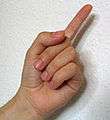 1 一 yī
1 一 yī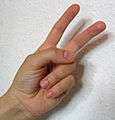 2 二 èr
2 二 èr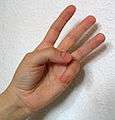 3 三 sān
3 三 sān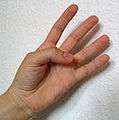 4 四 sì
4 四 sì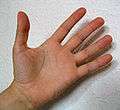 5 五 wǔ
5 五 wǔ
Note:hand signs are the same as Western hand signs. Source: commons:數字手勢